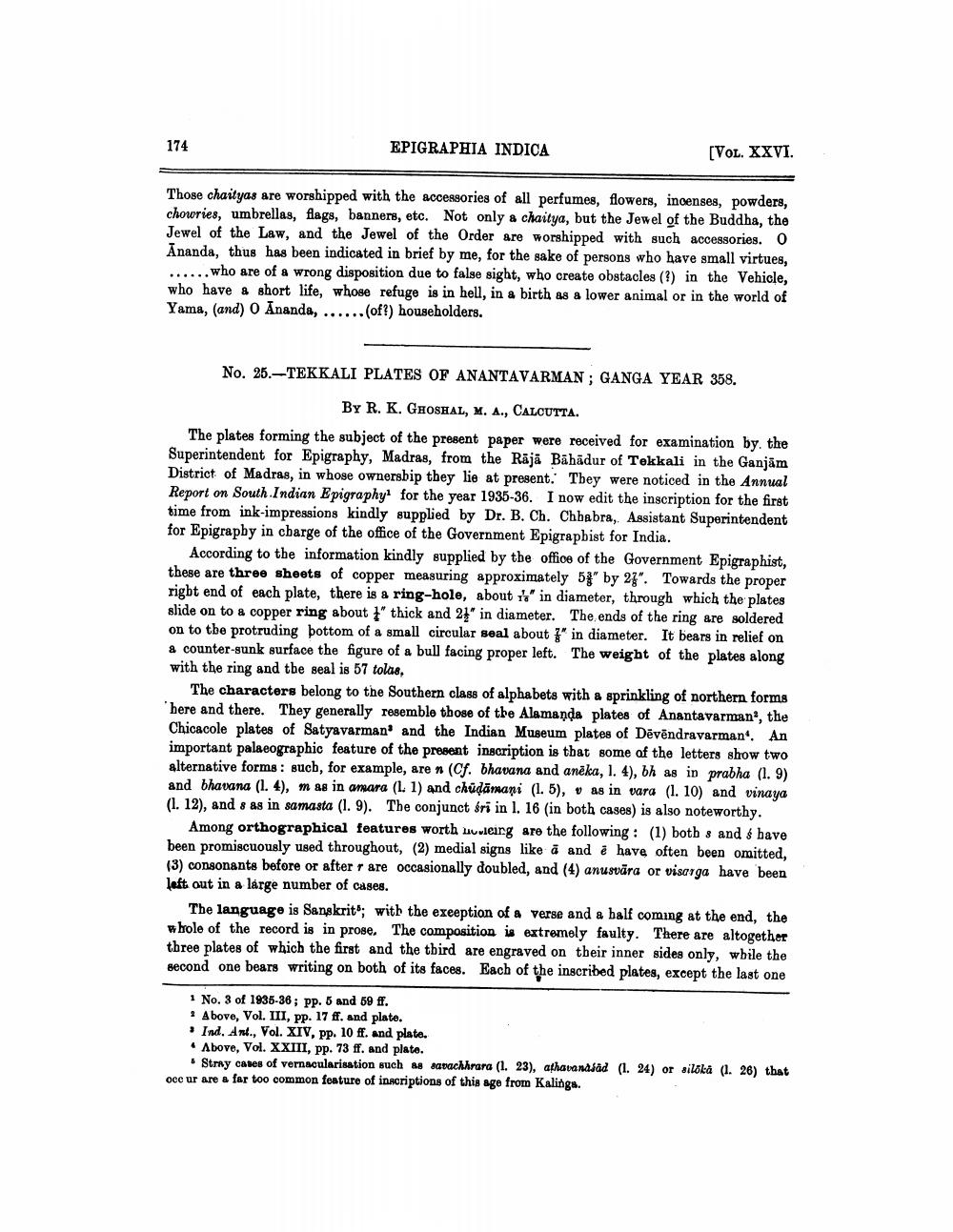________________
174
EPIGRAPHIA INDICA
(VOL. XXVI.
Those chaityas are worshipped with the accessories of all perfumes, flowers, incenses, powders, chowries, umbrellas, flags, banners, etc. Not only a chaitya, but the Jewel of the Buddha, the Jewel of the Law, and the Jewel of the Order are worshipped with such accessories. O Ananda, thus has been indicated in brief by me, for the sake of persons who have small virtues, ......who are of a wrong disposition due to false sight, who create obstacles (?) in the Vehicle, who have a short life, whose refuge is in hell, in a birth as a lower animal or in the world of Yama, (and) 0 Ananda, ......(of?) householders.
No. 25.-TEKKALI PLATES OF ANANTAVARMAN; GANGA YEAR 358.
BY R. K. GHOSHAL, M. A., CALCUTTA. The plates forming the subject of the present paper were received for examination by the Superintendent for Epigraphy, Madras, from the Rājā Bāhādur of Tekkali in the Ganjām District of Madras, in whose ownership they lie at present. They were noticed in the Annual Report on South Indian Epigraphy for the year 1935-36. I now edit the inscription for the first time from ink-impressions kindly supplied by Dr. B. Ch. Chhabra, Assistant Superintendent for Epigraphy in charge of the office of the Government Epigrapbist for India.
According to the information kindly supplied by the office of the Government Epigraphist, these are three sheets of copper measuring approximately 5%" by 28". Towards the proper rigbt end of each plate, there is a ring-hole, about in diameter, through which the plates slide on to a copper ring about t" thick and 21" in diameter. The ends of the ring are soldered on to the protruding bottom of a small circular seal about 7" in diameter. It bears in relief on a counter-sunk surface the figure of a bull facing proper left. The weight of the plates along with the ring and the seal is 57 tolas,
The characters belong to the Southern class of alphabets with a sprinkling of northern forms here and there. They generally resemble those of the Alamanda plates of Anantavarman, the Chicacole plates of Satyavarman' and the Indian Museum plates of Dēvēndravarman. An important palaeographic feature of the present inscription is that some of the letters show two alternative forms: sucb, for example, are n (Cf. bhavana and anēka, 1. 4), bh as in prabha (1.9) and bhavana (1.4), mas in amara (L. 1) and chudāmani (1.5), v as in vara (1. 10) and vinaya (1. 12), and 8 as in samasta (1. 9). The conjunct śri in l. 16 (in both cases) is also noteworthy.
Among orthographical features worth Lulearg are the following: (1) boths and & have been promiscuously used throughout, (2) medial signs like a and i have often been omitted, (3) consonants before or after r are occasionally doubled, and (4) anusvära or visarga have been left out in a large number of cases.
The language is Sanskrit; with the exeeption of a verse and a balf coming at the end, the whole of the record is in prose. The composition is extremely faulty. There are altogether three plates of which the first and the third are engraved on their inner sides only, while the second one bears writing on both of its faces. Each of the inscribed plates, except the last one
1 No. 3 of 1935-36; pp. 5 and 59 ff. * Above, Vol. III, pp. 17 ff. and plate.
Ind. Ant., Vol. XIV, pp. 10 ff. and plate. * Above, Vol. XXIII, pp. 73 ff. and plate.
• Stray cases of vernacularisation such as savachhrara (1. 23), athavanašad (1. 24) or siloka (1. 26) that occur are a far too common feature of inscriptions of this age from Kalings.




